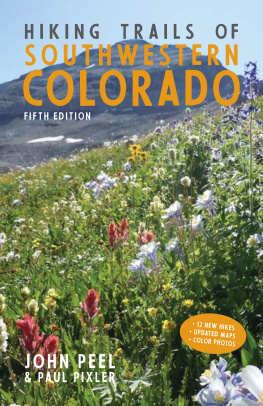Emma Walker - Best Dog Hikes Colorado
Here you can read online Emma Walker - Best Dog Hikes Colorado full text of the book (entire story) in english for free. Download pdf and epub, get meaning, cover and reviews about this ebook. year: 2019, publisher: Falcon Guides, genre: Home and family. Description of the work, (preface) as well as reviews are available. Best literature library LitArk.com created for fans of good reading and offers a wide selection of genres:
Romance novel
Science fiction
Adventure
Detective
Science
History
Home and family
Prose
Art
Politics
Computer
Non-fiction
Religion
Business
Children
Humor
Choose a favorite category and find really read worthwhile books. Enjoy immersion in the world of imagination, feel the emotions of the characters or learn something new for yourself, make an fascinating discovery.

- Book:Best Dog Hikes Colorado
- Author:
- Publisher:Falcon Guides
- Genre:
- Year:2019
- Rating:5 / 5
- Favourites:Add to favourites
- Your mark:
- 100
- 1
- 2
- 3
- 4
- 5
Best Dog Hikes Colorado: summary, description and annotation
We offer to read an annotation, description, summary or preface (depends on what the author of the book "Best Dog Hikes Colorado" wrote himself). If you haven't found the necessary information about the book — write in the comments, we will try to find it.
This guidebook reveals the 40 best hiking trails in Colorado that are dog friendly. Included throughout are color maps and photos, helpful tips and sidebars, and tailored hike specs for leash requirements. Introductory material includes helpful dog packing and preparation information before you hit the trail.
Best Dog Hikes Colorado — read online for free the complete book (whole text) full work
Below is the text of the book, divided by pages. System saving the place of the last page read, allows you to conveniently read the book "Best Dog Hikes Colorado" online for free, without having to search again every time where you left off. Put a bookmark, and you can go to the page where you finished reading at any time.
Font size:
Interval:
Bookmark:
Certain items are necessary, and desirable, to make your day hikes with your dog safer and more enjoyable. The following list describes gear options that can increase your safety and that of your dog, enhancing your hiking experience. Many of the day hike equipment items are also essential building blocks to a successful backpacking excursion.
COLLARS AND HARNESSES
Either a collar or harness is suitable, but a colorful harness makes your dog more visible and identifies them as domestic. For dogs of intimidating size or appearance, a colorful harness emphasizes their pet status. It is easier to restrain a dog by a harness than a collar when necessary. In addition, a harness is a safer restraint (a collar could slip off or choke your dog) should you need to pull them out of water or hoist them up a hillside. Harnesses are safer than collars off leash because they reduce the risk of neck injury or suffocation from a snag or tangle in brush or with a branch. With an adult dog who insists on pulling you along, the harness will give you more control and prevent damage to his neck and throat.
Material: Although leather is the most durable, nylon collars and harnesses are available in vibrant colors, are usually adjustable, and dry more quickly and without shrinkage. Your dog is less likely to lose a collar or harness with a plastic snap-in clasp than a metal buckle when hes running, swimming, and jostling about.
Fit: You should be able to easily slip your flat hand under the collar and rotate it; however, the collar should not be so loose that it can slip over your dogs head. A puppy will need to be fitted with a new collar a few times as he grows. Harnesses need to fit loosely enough to allow full expansion of the chest and a free stride.
Many trainers now consider choke collars an inhumane training tool, and a choke collar as a permanent collar can be deadly. To mention a few real-life scenarios: One dog was strangled when another dogs jaw got twisted in the choke collar during rambunctious play; another dog snagged his choke collar on a low branch while running through the brush; and another slipped and fell off a boulder, hanging himself at the end of a leash and choke collar.
IDENTIFICATION TAGS
The sight, smell, or sound of another animal could lure your dog away, and thunder or gunshots could startle your dog and cause them to run off. Whatever the reason for the separation, you want to facilitate a reunion. On the trail a tag is the most obvious way to reunite a lost dog and its owner. The information should include the dogs name (and your last name) and a phone number, at the very least. (Some owners put a physical address on the tag; this is up to you.) If another person gets close enough to your dog to see the tag, the first thing he or she will look for is a name. Calling the dog by its name will establish some communication and trust. The phone number allows the finder to leave a message. Along with your dogs nametag, attach an up-to-date rabies tag to their collar. This is required in some areas, and its never a bad idea to let the humans who find your dog know theyre vaccinated.
LEASHES
A leash that will suffer the abuse of the trail (streams, rain, snow, and rocks) must be durable. On the one hand, a colored nylon webbing leash is light, dries quickly, and is easy to spot when you lay it down. You can design your own leash inexpensively by buying nylon webbing by the foot at a mountaineering store and the clasp at a hardware store. (I use a carabiner in place of a traditional clasp, since my dog is stronger than he appears and has broken more than one clasp when in hot pursuit of rabbits.)
On the other hand, leather leashes stay the cleanest and last forever. Place a piece of colored tape or tie a strand of colored fabric to the handle to make finding the leash easier when it is on the ground. Leather leashes are often required in obedience classes.
If you are hiking in a strictly on-leash environment, expandable leashes blend control and freedom. The leashes come in varied lengths and strengths based on dog weight. An expandable leash can also convert into a tie-out line.
REFLECTIVE VEST
If you are going to hike during hunting season, your dog should wear a bright, lightweight reflective vest, specially designed for sporting dogs. This will help distinguish your dog from wildlife.
BOOTIES
If your dog is only an occasional hiker that spends most of his time sauntering across the lawn at home, his pads may get tender after just a couple of miles. Booties can give relief to your dogs sore paws until his pads toughen, as well as prevent cuts from crusty or icy trail conditions. Your dog should practice wearing booties at home before using them on the trail.
Where to buy booties: Booties come in different sizes and materials and are available through pet supply stores, mail-order and online outlets, and mountaineering stores, and are also advertised in dogsledding magazines.
DOG PACKS
Although it is a good idea to introduce young dogs to the idea of packs, loaded packs should be used only on fit, medium-to-large adult dogs (thirty-five pounds or more). Most packs are designed to lie on the dogs back like a saddle with a pouch on each side. The pack weight should not exceed one-quarter to one-third of your dogs weight. (For example, a forty-pound dog should not carry more than ten to thirteen pounds of evenly distributed weight.)
Packs are more appropriate for overnight trips than day hikes. Theres significantly more gear when you go overnight, and its a good use of dog power to train a medium-or large-size dog to assist by carrying her booties, first-aid kit, food and treats, and other accessories related to her needs. (See the introduction for pack-training information.)

Choosing packs: Packs are sold in pet supply stores, outdoor recreation stores, and mail-order and online outlets. They come in different sizes with adjustable straps. Look for the design that best conforms to your dogs body. The pack should feature breathable material, rounded corners, and padding for additional comfort.
Pack fitting: Your dogs comfort depends on a proper fit. The pack should sit on his shoulders between the base of the neck and just short of the hips. There should be one strap that clips on the front of his chest and one or two belly straps to stabilize the pack. Straps should be tight enough to keep the pack in place but loose enough to allow full stride without chafing and comfortable expansion of the chest for breathing.
Loading the pack: Stuff the pack with crumpled newspaper first. Then, once your dog is accustomed to the pack and his endurance has built up, gradually increase the load from 10 percent of his weight not to exceed one-quarter to one-third of his weight. If you use a pack only occasionally, keep the weight on the lighter side. The weight should be equal and evenly distributed to avoid interfering with your dogs balance.
Pack safety: Keep your dog on leash when he is wearing his pack. Packs can make balance awkward when negotiating narrow mountainside trails or crossing fast streams. Give him a break every hour or so by removing the pack so he can enjoy the freedom you both came for by playing, swimming, and rolling around without risking injury to himself and damage to his pack and cargo.
LIFE VEST
A life vest is important to have if you are going to hike near rivers and lakes or if you have to cross high water, especially with dogs that are drawn to water. An elderly or tired dog is more at risk in the water during a hike than she would be at the beach for the day.
Font size:
Interval:
Bookmark:
Similar books «Best Dog Hikes Colorado»
Look at similar books to Best Dog Hikes Colorado. We have selected literature similar in name and meaning in the hope of providing readers with more options to find new, interesting, not yet read works.
Discussion, reviews of the book Best Dog Hikes Colorado and just readers' own opinions. Leave your comments, write what you think about the work, its meaning or the main characters. Specify what exactly you liked and what you didn't like, and why you think so.




